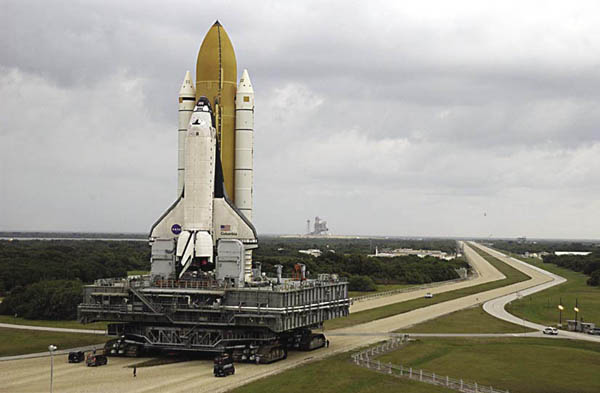AN INTRODUCTION TO THE SPACE SHUTTLE
―スペースシャトルの基礎知識―
―スペースシャトルの基礎知識―
The Space Shuttle is one of the most complex machines ever devised. Its main elements ュ the Orbiter, Space Shuttle Main Engines, External Tank, and Solid Rocket Boosters ュ are assembled from more than 2.5 million parts, 230 miles of wire, 1,060 valves, and 1,440 circuit breakers. Weighing approximately 4.5 million-pounds at launch, the Space Shuttle accelerates to an orbital velocity of 17,500 miles per hour ュ 25 times faster than the speed of sound ュ in just over eight minutes. Once on orbit, the Orbiter must protect its crew from the vacuum of space while enabling astronauts to conduct scientific research, deploy and service satellites, and assemble the International Space Station. At the end of its mission, the Shuttle uses the Earths atmosphere as a brake to decelerate from orbital velocity to a safe landing at 220 miles per hour, dissipating in the process all the energy it gained on its way into orbit.
スペースシャトルはこれまで作られた機械の中で最も複雑なもののひとつです。主要な部分は、オービター、スペースシャトルメインエンジン、外部燃料タンク、固体燃料ロケットブースターからなり、2,500万点のパーツ、230マイル(370km)のケーブル、1060個のバルブ、1,440個のブレーカーが使われています。重さは打上げ時で約4500万ポンド(約2万トン)あります。スペースシャトルは軌道速度である時速17,500マイル(28,000km/h)―音速の25倍の速さ―まで加速するのに8分しかかかりません。軌道上では、オービターは宇宙飛行士が科学実験や衛星の放出、メンテナンス、国際宇宙ステーションの組み立てなどを行っている間、彼らを真空から保護しなければなりません。そして、ミッションの最後には、シャトルは地球の大気をブレーキにして、軌道速度から安全に着陸できる時速220マイルまで速度を落とします。この過程で、シャトルは軌道に上がることで得たエネルギーをすべて捨てることになります。
THE ORBITER
THE ORBITER ―オービター―
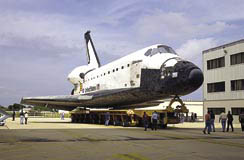
The Orbiter is what is popularly referred to as "the Space Shuttle." About the size of a small commercial airliner, the Orbiter normally carries a crew of seven, including a Commander, Pilot, and five Mission or Payload Specialists. The Orbiter can accommodate a payload the size of a school bus weighing between 38,000 and 56,300 pounds depending on what orbit it is launched into. The Orbiters upper flight deck is filled with equipment for flying and maneuvering the vehicle and controlling its remote manipulator arm. The mid-deck contains stowage lockers for food, equipment, supplies, and experiments, as well as a toilet, a hatch for entering and exiting the vehicle on the ground, and - in some instances - an airlock for doing so in orbit. During liftoff and landing, four crew members sit on the flight deck and the rest on the mid-deck.
オービターは、一般的に「スペースシャトル」と呼ばれているものです。だいたい、小さな旅客機ぐらいのサイズで、普通7人の乗員―船長、パイロット、5人のミッション/ペイロードスペシャリスト―を乗せています。オービターには、大きさにしてスクールバスぐらい、重さにして38,000〜56,300ポンド(17,200〜25,500kg)の積荷を積むことができます(ただしこれは目指す軌道によって変わってきます)。オービター上部のフライトデッキは機体を飛ばしたり姿勢制御を行うための機器や、遠隔操作のマニピュレーターを操作するための機器で占められています。その下のミッドデッキには、食料や機器、日用品、実験機材などが収められたロッカーやトイレ、地上での出入りを行うためのハッチ、また同じように軌道上で出入りするためのエアロックなどがあります。打ち上げの時や着陸時には、4人の乗員がフライトデッキに、残りの乗員はミッドデッキに座ります。
Different parts of the Orbiter are subjected to dramatically different temperatures during re-entry. The nose and leading edges of the wings are exposed to superheated air temperatures of 2,800 to 3,000 degrees Fahrenheit, depending upon re-entry profile. Other portions of the wing and fuselage can reach 2,300 degrees Fahrenheit. Still other areas on top of the fuselage are sufficiently shielded from superheated air that ice sometimes survives through landing.
大気圏突入時には、オービターの各部分は驚くほど違う温度に晒されます。条件にもよりますが、機首と翼の前縁部分は華氏2800〜3000度(約1570〜1650℃)の超高温の空気に晒されることになります。また、翼の他の部分や胴体は華氏2300度(約1260℃)になります。しかし、胴体の上部は超高温の空気からしっかりと守られ、時には着陸の時まで氷が残っていることもあります。
To protect its thin aluminum structure during re-entry, the Orbiter is covered with various materials collectively referred to as the Thermal Protection System. The three major components of the system are various types of heat-resistant tiles, blankets, and the Reinforced Carbon-Carbon (RCC) panels on the leading edge of the wing and nose cap. The RCC panels most closely resemble a hi-tech fiberglass ュ layers of special graphite cloth that are molded to the desired shape at very high temperatures. The tiles, which protect most other areas of the Orbiter exposed to medium and high heating, are 90 percent air and 10 percent silica (similar to common sand). One-tenth the weight of ablative heat shields, which are designed to erode during re-entry and therefore can only be used once, the Shuttles tiles are reusable. They come in varying strengths and sizes, depending on which area of the Orbiter they protect, and are designed to withstand either 1,200 or 2,300 degrees Fahrenheit. In a dramatic demonstration of how little heat the tiles transfer, one can place a blowtorch on one side of a tile and a bare hand on the other. The blankets, capable of withstanding either 700 or 1,200 degrees Fahrenheit, cover regions of the Orbiter that experience only moderate heating.
大気圏突入の間、その薄いアルミの構造を守るために、オービターは耐熱システムという名前で総称される様々な材質で覆われています。このシステムの主要な構成要素は3つ、様々なタイプの耐熱タイル、耐熱布、そして翼の前縁部と機首に使われている強化カーボン-カーボンパネル(RCCパネル)です。RCCパネルに一番似ているのはファイバーグラスで、特殊な黒鉛で作られた布を重ね、高温で目的の形に整形したものです。オービターの中ぐらいないし高温に晒されるそれ以外のほとんどの部分を保護しているタイルは、90%が空気で、10%が珪素(つまり砂と同じです)から出来ています。溶融型の耐熱システム―大気圏突入時に失われてしまうために一度しか使用できない―に比べて1/10の重さしかないにもかかわらず、再利用が出来るのです。強さやサイズを変えられる上に、使われる場所にもよりますが、華氏1,200〜2,300度(約650〜1260℃)まで耐えられるように作られています。その断熱効果を示すいい例を紹介しましょう。例えばこのタイルの上の面をバーナーであぶっていたとしても、下の面を直接手のひらの上に載せられるのです。耐熱布は、華氏700〜1,200度(約370〜650℃)に耐え、さほど温度が上がらない場所に使用されています。
SPACE SHUTTLE MAIN ENGINES
SPACE SHUTTLE MAIN ENGINES ―スペースシャトル メインエンジン―
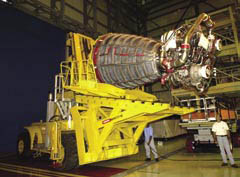
Each Orbiter has three main engines mounted at the aft fuselage. These engines use the most efficient propellants in the world - oxygen and hydrogen - at a rate of half a ton per second. At 100 percent power, each engine produces 375,000 pounds of thrust, four times that of the largest engine on commercial jets. The large bell-shaped nozzle on each engine can swivel 10.5 degrees up and down and 8.5 degrees left and right to provide steering control during ascent.
それぞれのオービターは、胴体の後部に3機のメインエンジンを搭載しています。これらのエンジンは、世界で最も効率のいい燃料―酸素と水素―を一秒間に500kgづつ使用します。最大出力時のそれぞれのエンジンの推力は375,000ポンド(約170,000kg)。これは、最も大きな旅客機のエンジンの4倍にあたります。それぞれのエンジンの巨大なベル型のノズルは、上下に10.5度、左右に8.5度の範囲で向きを変えることができ、打上げ時のコントロールを提供します。
EXTERNAL TANK
EXTERNAL TANK ―外部燃料タンク―
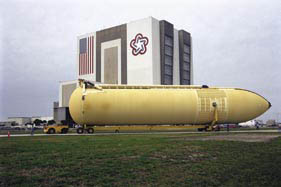
The three main engines burn propellant at a rate that would drain an average-size swimming pool in 20 seconds. The External Tank accommodates up to 143,351 gallons of liquid oxygen and 385,265 gallons of liquid hydrogen. In order to keep the super-cold propellants from boiling and to prevent ice from forming on the outside of the tank while it is sitting on the launch pad, the External Tank is covered with a one-inch-thick coating of insulating foam. This insulation is so effective that the surface of the External Tank feels only slightly cool to the touch, even though the liquid oxygen is stored at minus 297 degrees Fahrenheit and liquid hydrogen at minus 423 degrees Fahrenheit. This insulating foam also protects the tanks aluminum structure from aerodynamic heating during ascent. Although generally considered the least complex of the Shuttles main components, in fact the External Tank is a remarkable engineering achievement. In addition to holding over 1.5 million pounds of cryogenic propellants, the 153.8-foot long tank must support the weight of the Orbiter while on the launch pad and absorb the 7.3 million pounds of thrust generated by the Solid Rocket Boosters and Space Shuttle Main Engines during launch and ascent. The External Tanks are manufactured in a plant near New Orleans and are transported by barge to the Kennedy Space Center in Florida. Unlike the Solid Rocket Boosters, which are reused, the External Tank is discarded during each mission, burning up in the Earths atmosphere after being jettisoned from the Orbiter.
三つのメインエンジンは、普通のスイミングプールを20秒で空にしてしまうほどの勢いで燃料を消費します。外部燃料タンクは143,351ガロン(約542,600リットル)の液体酸素、そして385,265ガロン(1,458,400リットル)の液体水素を収納しています。極低温の燃料が沸騰してしまうのを防ぎ、発射台の上でタンクの外側に氷がついてしまうのを防止するために、外部燃料タンクは1インチの厚さの断熱材に覆われています。この断熱材はとても効果が高く、内部の液体水素が華氏マイナス297度(約-182.7℃)、液体水素が華氏マイナス423度(約-252.7℃)に保持されていても、外部燃料タンクの表面は少し冷たく感じる程度です。また、この断熱材は、上昇時の空力的な熱から、タンクのアルミの構造材を保護する役目も果たします。スペースシャトルの主要な3つコンポーネントの中でも、この外部燃料タンクは驚くべき工学的な進歩の結晶といえます。1,500,000ポンド(680,000kg)の極低温の燃料を搭載するだけではなく、この153.8フィート(約46.8m)のタンクは、発射台の上でオービターの全重量を支え、さらに打上げ時と上昇時には固体燃料ロケットとオービターが生み出す7,300,000ポンド(約3,311,200kg)の推力を吸収するのです。外部燃料タンクは、ニューオルリンズの近くの工場で製造され、フロリダのケネディ宇宙センターまではしけ(平底の運搬船)で運ばれます。再使用される固体燃料ロケットブースターと違い、外部燃料タンクは、オービターから切り離されると地球の大気で燃え尽き、それぞれのミッションごとに使い捨てにされます。
SOLID ROCKET BOOSTERS
SOLID ROCKET BOOSTERS ―固体燃料ロケットブースター―
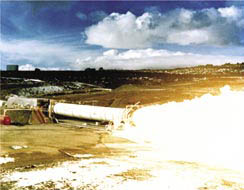
A Solid Rocket Booster (SRB) Demonstration Motor being tested near Brigham City, Utah.
デモンストレーション用の固体燃料ロケットブースター(Solid Rocket Booster:SRB) のテスト。
ユタ州、ブリガムシティ近郊。
ユタ州、ブリガムシティ近郊。
Despite their power, the Space Shuttle Main Engines alone are not sufficient to boost the vehicle to orbit ュ in fact, they provide only 15 percent of the necessary thrust. Two Solid Rocket Boosters attached to the External Tank generate the remaining 85 percent. Together, these two 149-foot long motors produce over six million pounds of thrust. The largest solid propellant rockets ever flown, these motors use an aluminum powder fuel and ammonium perchlorate oxidizer in a binder that has the feel and consistency of a pencil eraser.
シャトルのメインエンジンはかなり強力ですが、それだけではシャトルを軌道に乗せることはできません。実は、メインエンジンは必要な推力の15%しか発生していないのです。外部燃料タンクに接続された2本の固体燃料ロケットが、残りの85%を生み出しています。149フィート(約45.4m)あるこの2本のロケットモーターは、両方あわせて6,000,000ポンド(2,721,600kg)の推力を生み、実際に飛行した中では最も大きな固体燃料ロケットです。これらのモーターは、アルミニウムの粉末燃料とアルミニウム過塩素酸塩アルミニウムの酸化剤が、結合材の中に混ぜられたものを燃料として使用しています。この燃料、触った感じや硬さは消しゴムそっくりです。
※訳注:固体燃料ロケットの場合、「エンジン」ではなく「モーター」と呼ばれるのが一般的です。
Each of the Solid Rocket Boosters consists of 11 separate segments joined together. The joints between the segments were extensively redesigned after the Challenger accident, which occurred when hot gases burned through an O-ring and seal in the aft joint on the left Solid Rocket Booster. The motor segments are shipped from their manufacturer in Utah and assembled at the Kennedy Space Center. Once assembled, each Solid Rocket Booster is connected to the External Tank by bolts weighing 65 pounds each. After the Solid Rocket Boosters burn for just over two minutes, these bolts are separated by pyrotechnic charges and small rockets then push the Solid Rocket Boosters safely away from the rest of the vehicle. As the boosters fall back to Earth, parachutes in their nosecones deploy. After splashing down into the ocean 120 miles downrange from the launch pad, they are recovered for refurbishment and reuse.
それぞれの固体燃料ロケットは、11の分割されたパーツからできています。これらのパーツの接続部分はチャレンジャー事故の後、広範囲に渡って再設計されました。事故では、左の固体燃料ロケット後部の接続部分のOリングとシールが高温のガスで焼かれ、そこからガスが噴出したのです。ロケットモーターのパーツはユタ州で製造され、ケネディ宇宙センターまで船で運ばれた後、組み立てられます。その後、それぞれの固体燃料ロケットは、外部燃料タンクに、一本65ポンド(約29,4kg)のボルトで接続されます。固体燃料ロケットが2分で燃え尽きた後、これらのボルトが火薬で分割され、小さなロケットでシャトルのそれ以外の部分から引き離されます。地球に向かって落下しながら、ブースターは機首のノーズコーンからパラシュートを開き、発射場から120マイル(約193.1km)離れた海の上に着水します。そして、洗浄、修理され再使用されるのです。
THE SHUTTLE STACK
THE SHUTTLE STACK ―シャトルの組み立て―
The first step in assembling a Space Shuttle for launch is stacking the Solid Rocket Booster segments on the Mobile Launch Platform. Eight large hold-down bolts at the base of the Solid Rocket Boosters will bear the weight of the entire Space Shuttle stack while it awaits launch. The External Tank is attached to the Solid Rocket Boosters, and the Orbiter is then attached to the External Tank at three points ュ two at its bottom and a "bipod" attachment near the nose. When the vehicle is ready to move out of the Vehicle Assembly Building, a Crawler-Transporter picks up the entire Mobile Launch Platform and carries it ュ at one mile per hour ュ to one of the two launch pads.
打上げのためのスペースシャトル組み立ての最初のステップは、固体燃料ロケットのパーツを移動発射台(Mobile Launch Platform)の上で積み上げることです。打上げまでの間は、固体燃料ロケット下部の8本の巨大な固定ボルトで、スペースシャトルの全てのコンポーネントが支えられることになります。次に外部燃料タンクが固体燃料ロケットに接続され、最後に、オービターが外部燃料タンクに3箇所―2つはタンクの底、1つは機首近くのバイポッド(2脚)―で接続されます。シャトルを機体組立棟(Vehicle Assembly Building:VAB)から出す準備が整うと、クロウラー・トランスポーターが移動発射台全体を持ち上げ、時速1マイルのスピードで2ヶ所ある発射台の内の1つへと運びます。
